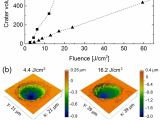Reactive high power pulsed magnetron sputtering system (r-HIPIMS) was used for the deposition of nanocomposite layers CuCNx on milling tools. This coating damps vibration of this tool during a milling process. This coating is composed of composite layers CuCNx and metallic Cu interlayers. These interlayers improved adhesion and cohesion of this coating and further increased damping of mechanical vibration. These multilayers were deposited by the r-...








